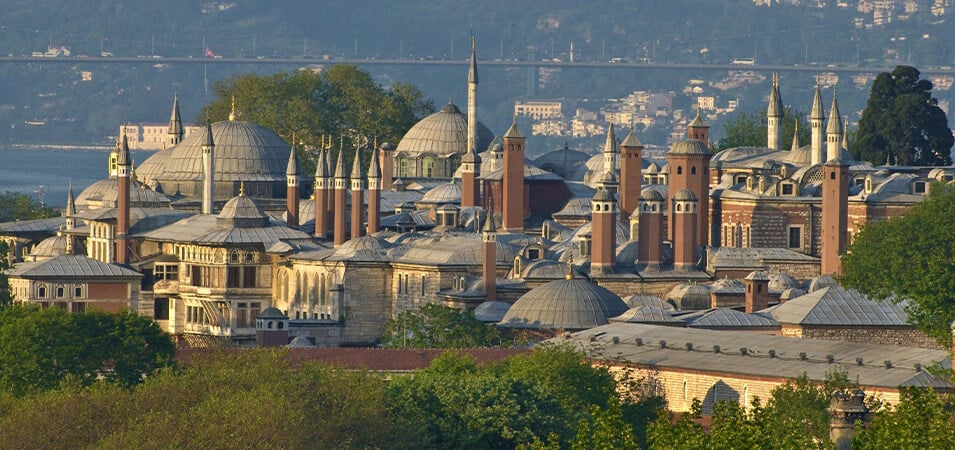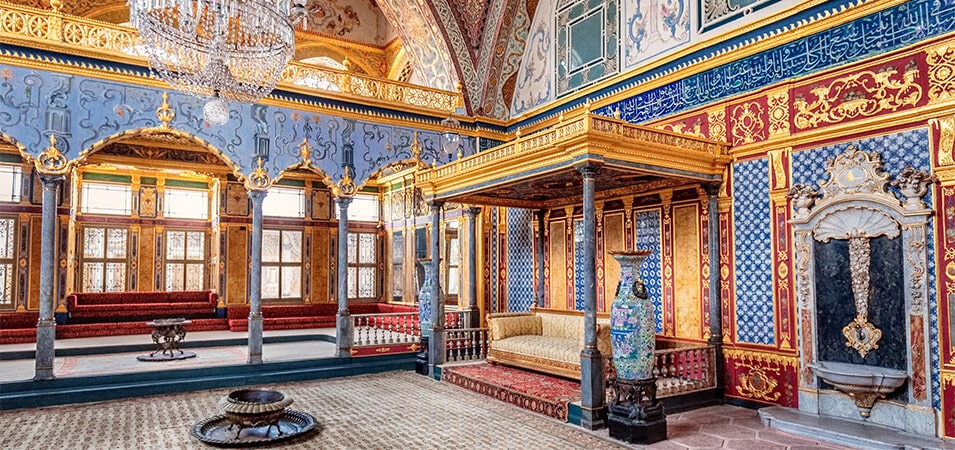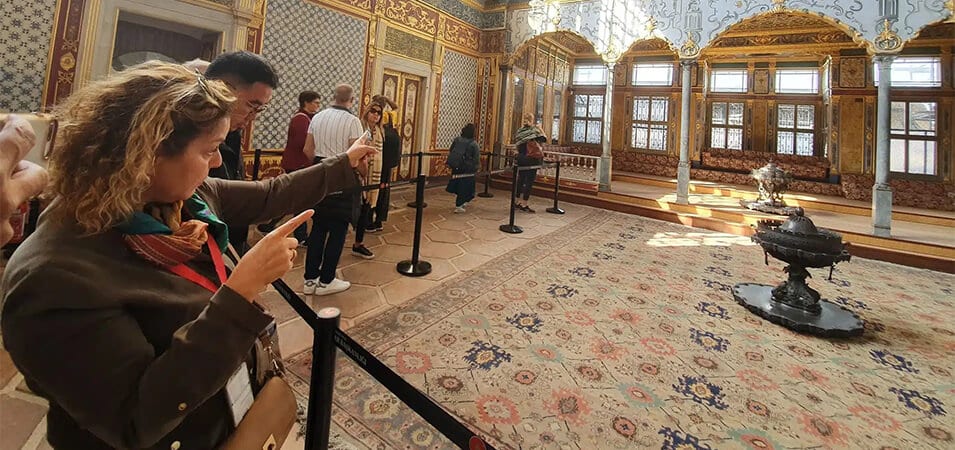The Royal Topkapi Palace is a famous historical site in the middle of the busy city of Istanbul in Turkey. It has an important place in history because of its beautiful buildings and rich cultural past. This beautiful house was the home of the Ottoman sultans for more than 400 years. It showed how powerful and wealthy they were.
The Royal Topkapi Palace, or Topkapi Sarayi as it is called in Turkish, was built in the 1500s and became the center of the Ottoman Empire. Its vast complex has many beautiful buildings, lush parks, and complicated courts. It was the king’s home and the center of the empire’s government.
Visitors can look around the many rooms of the Royal Topkapi Palace, such as the Harem, where the sultan’s family lived, and the Imperial Council Chamber, where important decisions were made. The castle also has a fantastic collection of artifacts, such as beautiful jewelry, weapons, and religious artifacts.
Today, the Royal Topkapi Palace is a reminder of how great and beautiful the Ottoman Empire was. It gives tourists a glimpse into an age of royal glory from the past. It is still a well-loved sign of Turkey’s rich cultural past and a must-see for history buffs and tourists.
Don’t Miss checking out our Turkey Tour Packages.
Construction and Development of the Royal Topkapi Palace

- Sultan Mehmed, the Conqueror, started building the Royal Topkapi Palace in 1459. He wanted a beautiful home that fit the rank of the Ottoman Empire. The house was carefully placed on the Seraglio Point, which looked out over the Golden Horn. From there, it had beautiful views of Istanbul and the Bosporus Strait.
- Over the ages, the palace has grown and been fixed up many times, turning it into a vast building that covers about 700,000 square meters. Different sultans helped build it up by adding new buildings, parks, and patios, each representing the architectural style and tastes of its time.
The Primary Residence of the Ottoman Sultans
- From the 15th century until the 19th century, when the empire’s capital moved to the Dolmabahce Palace, the Ottoman sultans lived and ran their kingdom from the Royal Topkapi Palace. It was not only the sultan’s home but also a sign of his authority, power, and wealth.
- The palace was built so the sultan’s large court, which included officials, concubines, and staff, could live there. Important government activities, like the Imperial Council, took place. The palace also had private rooms for the sultan’s family, like the famous Harem, where the sultan’s wives, concubines, and other female cousins lived.
- The castle building was not only a place for people to live but also a place for arts and culture. It had places like libraries, schools, churches, and other buildings that helped people learn and make art. The sultans put on a show in the palace a fantastic collection of items, such as valuable gold, texts, works of art, and religious objects.
- The house was important for more than just being home. It was a sign of the empire’s power and wealth, showing how rich and diverse the Ottoman culture was. Combining Islamic, Byzantine, and European styles, the Royal Topkapi Palace became a sign of the empire’s skill as a builder.
Architecture and Design of the Royal Topkapi Palace
The Royal Topkapi Palace is a beautiful building with a design that mixes Ottoman, Byzantine, and Persian styles. How it is set up shows how grand and rich the Ottoman Empire was.
- Courtyards and Entrances: The castle has several gardens, each with a different function. The first area’s entrance, the Imperial Gate, is a huge archway and colossal stone walls. It leads to the Gate of Salutation, which gives entry to the second square, the Divan Square. This square was where the king and his ministers would meet.
- Rooms and Halls: The building has many rooms and halls, each with detailed architectural features. The Audience Hall (Divan-i Hümayun) has a high ceiling with a dome and big windows that give it a grand feeling. The Privy Chamber (Has Oda) was the sultan’s private room. It was beautifully decorated with intricate wood designs and brightly colored tiles. The impressive dome and marble columns of the Council Chamber (Kubbealt) were where vital political and religious talks occurred.
- The Harem: The Harem, where the sultan’s wives, concubines, and female cousins lived, is one of the most famous parts of the palace. It is set up like a maze, with connecting rooms and gardens. This gives the people who live there peace and protection. The Harem’s ceilings, marble pools, and beautiful tilework are all stunning examples of Ottoman architecture.
- Gardens and Pavilions: The Royal Topkapi Palace has gorgeous grounds for a peaceful setting. There are many buildings, shops, and decks on the grounds where the sultan and his guests can relax and take in the beauty of nature. The Circumcision Room (Sünnet Odas) is a well-known house with beautiful views of the sea and detailed woodwork.
- Styles from the Ottoman Empire, Byzantium, and Iran had an effect: The style of the Royal Topkapi Palace’s building is a mix of many different types. The kind of Ottomans can be seen in the giant domes, pointed arches, and elaborate designs. Byzantine effects can be seen in the use of marble and the service of parts from the Byzantine buildings that used to be there. Using grounds as an essential part of the house shows that it was influenced by Persian culture.
Art and Decorations
The Royal Topkapi Palace is full of beautiful works of art and decorations that show how skilled and creative the people of the Ottoman Empire were. The castle has elaborate tilework, writing, and exquisite paintings.
- The walls and rooms of the house are decorated with beautiful zink tiles. These tiles have bright colors and detailed designs that often show flowers or geometric shapes. The tilework shows how skilled the Ottoman artists were because of how well it was made and how much attention to detail it had.
- Calligraphy, highly valued in Islamic culture, can be seen throughout the castle. You can see lines from the Quran or beautiful writings written in Arabic script on the walls, pillars, and roofs. The beauty and skill of the report show how important it was in Ottoman culture to write things down and be holy.
- Intricate wood and stone carvings in different parts of the palace show how skilled Ottoman artists were. Floral and geometric designs are carefully carved into the doors, ceilings, and furniture, giving the palace’s rooms a rich and beautiful look.

Collections and Treasures of the Empire
The Royal Topkapi Palace is home to a beautiful collection of historical and culturally critical royal jewels and collections. These collections have beautiful pieces of jewelry, books, and holy artifacts.
- The palace is primarily known for its gold collection, which has many detailed and expensive pieces. Crowns, chains, and ceremonial swords with gems are on display to show how wealthy and luxurious the Ottoman sultans were.
- The house also has collections of manuscripts and printed books. The Ottoman Empire loved books, poems, and calligraphy; these beautifully made documents show that. Many of these texts have beautiful pictures and works by well-known poets and thinkers.
- The palace is where spiritually critical religious items and artifacts are kept. These include things connected to Islamic leaders and people, like the Prophet Muhammad’s things and other holy objects. These essential gems show how much the Ottoman Empire cared about Islam.
The collections and riches in the Royal Topkapi Palace are a sign of the empire’s wealth and its religious and cultural history. They give us a look into Ottoman culture’s intellectual, moral, and artistic sides.
Gardens and beautiful views
The Royal Topkapi Palace has beautiful grounds and countryside views, adding to its overall beauty. The palace’s foundations were carefully planned and were an essential part of the building of Ottoman palaces.
- One of the most popular parks near the palace is Gülhane Park, which means “Rosehouse Park.” It is a vast green space with carefully designed gardens, flower beds, and quiet paths. Gülhane Park is a peaceful place where people can walk, relax, and enjoy the beauty of nature.
- The grounds in the royal complex were carefully designed to blend nature and building in a way that looks good. They had pretty trees, flowers that smelled good, and incredible waterfalls that added to the castle’s beauty. These grounds were also where the sultans and their court went to have outdoor parties, picnics, and other fun activities.
- You can see Istanbul, the Bosporus Strait, and the Golden Horn from the Royal Topkapi Palace. The views are stunning. These views were beautiful and reminded people of where the kingdom was and how powerful it was over important trade lines.

Conclusion
the Royal Topkapi Palace is a magnificent reminder of the great Ottoman Empire and its importance in history. Its awe-inspiring architecture, detailed decorations, and extensive collections of art and riches signify Ottoman power, architectural beauty, and cultural history.
For hundreds of years, the palace was the primary home of the Ottoman sultans. It was the center of political, economic, and artistic life. It shows how prosperous the kingdom was and how skilled the people who worked there were, from the beautiful tilework and writing to the intricate carvings and jewelry.
Don’t Miss to Check out our Related Article :
